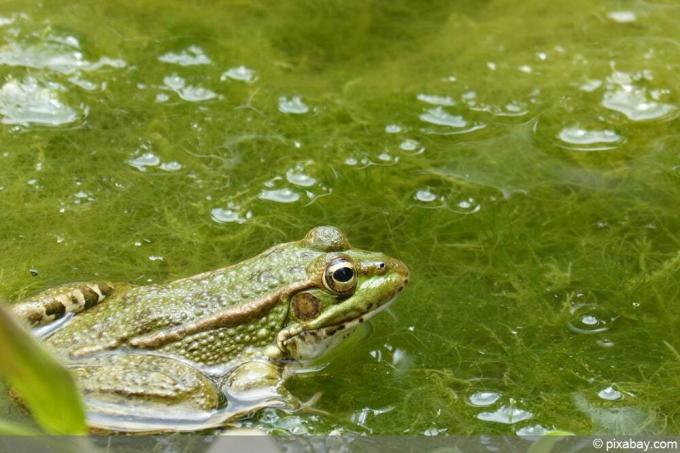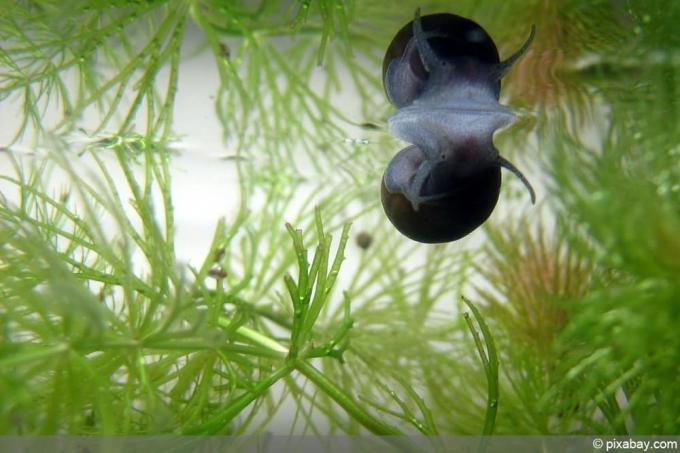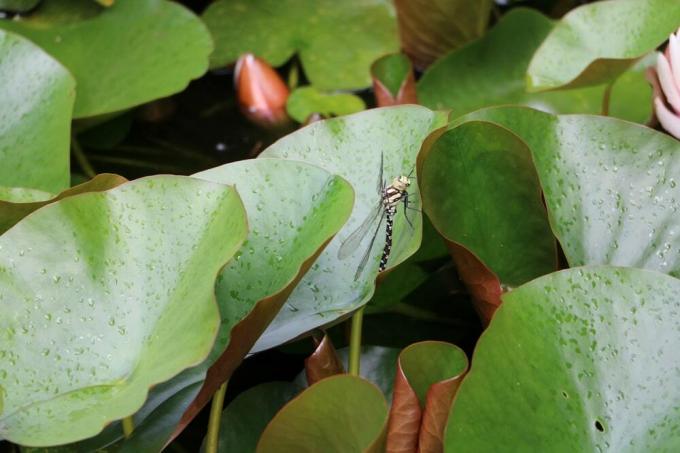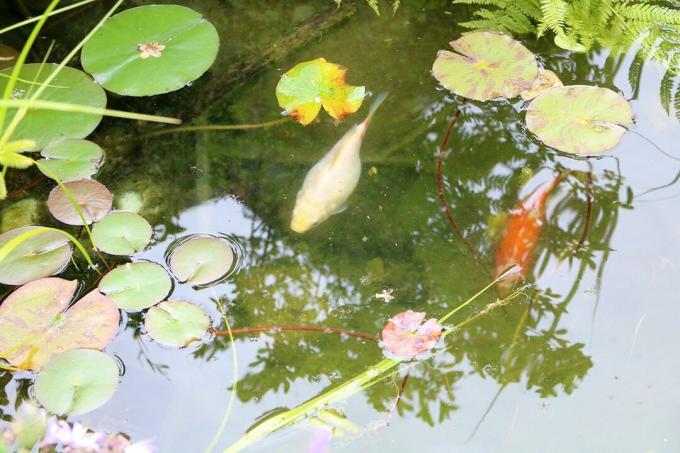

Table of contents
- microorganisms
- algae
- insects and larvae
- frogs
- toads
- newts
- water snails
- fish
- Shellfish
- birds
- Attract and protect living beings
- Caution: nets are dangerous
Creatures in and around the pond revitalize the water and enrich the biodiversity in the garden. They themselves can be useful, but they can also be the basis of nutrition for other animals. It is also interesting to follow the hustle and bustle in and around the water - and even educational, especially for children. But which creatures can be found and how do they get into the pond?
microorganisms
Microorganisms, especially bacteria, are among the first to colonize the garden pond. That's a good thing, because useful bacteria ensure the biological balance in the water and break down various substances. Others, on the other hand, can cause rot and thus have a negative impact on the water quality. Therefore, care must be taken to ensure that the organic material in the pond does not get out of hand. Dead plant parts, fallen leaves and animals that have died in the water must therefore be removed. Otherwise the water can “tip” – i.e. get out of balance. This is dangerous for the beneficial organisms and animals in the pond.
algae
When it comes to typical creatures in the pond, no one thinks of algae first, but they are also part of it and often settle in large numbers, much to the chagrin of the pond owner. It is quite natural to find few algae in the water. With larger amounts and especially with the so-called blue-green algae, caution is required and quick action is necessary.

The blue-green algae is a collection of cyanobacteria. Their spread is an indication that there are larger amounts of nutrients in the water. The algae produce other nutrients themselves and thus disturb the balance in the pond. If they die and sink to the bottom, the water can tip over. Favorable countermeasures are:
- Remove any contaminants such as leaves and plant parts from the water
- use a pond filter with UV light
- regularly remove pond sludge
- keep fish stocks low
- if necessary, use algae killers that are safe for aquatic life
- use silver carp or grass carp in large ponds
insects and larvae
As soon as the water is let into the pond, the first insects are already there. They fly over the surface of the water and stick to the plants near the pond. Some species use the water to lay eggs, which means that larvae can be seen in the pond within a very short time. Mosquito larvae can be problematic because they often occur in large numbers and are the first sign of a mosquito plague in the garden.
Appropriate countermeasures should be taken to prevent this from happening:
- Use fish that feed on the larvae
- Remove larvae from the water with a very fine-mesh quiver
- Attract beneficial insects such as frogs and common toads
Of course, not all insects in and around the garden pond are annoying or potentially harmful. The water also attracts dragonflies, water striders and various species of flies. In addition, the pond serves as a water source for many beneficial insects.
frogs
Frogs use the garden pond to lay their spawn and also protect themselves from predators in the water. The croaking is considered annoying by some people and can actually be very persistent and surprisingly loud some days of the year.
But everyone should put up with this little disturbance – because frogs are extremely useful. They feed on insects, keeping pests at bay. These include, for example, mosquitoes and mosquito larvae.
toads

Toads also spawn in the pond, but otherwise prefer to stay around the water and not in it. On their menu are large amounts of insects and their larvae, but also slugs. Anyone who discovers them in their own greenery should be happy about the help with pest control.
newts
Only those who sit quietly by the water for a long time and look closely will be able to observe amphibians from time to time - because the animals are shy and fast. But just like frogs and toads extremely useful. If some specimens are found during the pond cleaning, they should therefore be carefully placed in a bucket and put back in the pond as soon as possible.
water snails

Some pond owners charge a lot of money for water snails from the specialist trade, and the molluscs settle “by themselves” under the right conditions, so to speak. In some cases, they are also introduced via aquatic plants or other animals. Since some species feed on algae, among other things, they can serve well in the pond and improve the water quality.
fish
No fish were placed in the pond but they suddenly swim through the water? This is rare but possible. For example, when aquatic plants are taken over from a pond with fish and there was spawn on them. However, the spawn can also be brought in by other animals, because young fish can too then still hatch if the spawn is out of the water for several hours but moist was.
Of course, the fish can also be used and for many they are an essential part of a garden pond. However, those who choose these pond dwellers should pay attention to a few points:
size of the pond
When creating the pond, it should already be clear whether fish are to be kept in it later and what type of choice will be made. Because it depends on what volume of water is needed and how deep the garden pond has to be for safe overwintering.
Expectations
Easy-care goldfish or demanding koi? The effort required to keep them depends on the demands of the fish.
wintering
With the exception of koi, most types of fish can be overwintered in the garden pond without any problems, as long as it is deep and large enough and complete freezing is prevented.

compatibility
Goldfish are peaceful and can therefore be socialized with other peaceful species such as gold orfe and grass carp. However, this does not apply to all species and cultivated forms. When buying fish, you should therefore seek detailed advice from a specialist retailer.
Shellfish
Pond mussels are difficult to observe and often only come to light when the pond is cleaned. Their larvae can be introduced into the garden pond via fish and more rarely via plants. The larvae attach themselves to fish and initially live as parasites. When adult mussels develop from these larvae, the so-called glochidia, they feed on microorganisms and algae, which they filter out of the water. They can also contribute to good water quality.
birds
Garden ponds are attractive points for many birds, serving them as a source of water and food. They catch insects and drink from shallow areas. Larger ponds also occasionally attract ducks, which often go for a swim. But the visit of birds at the garden pond is not always so peaceful and beneficial. Especially when fish have been used, a visit from the gray heron or heron is rarely long in coming. The garden pond can also be life-threatening for young birds. The animals in the pond should therefore be protected in the same way as some animals in front of the pond.
Tip:
A heron dummy can keep the danger away from the fish, as it symbolizes flying animals that the garden pond is already "occupied".
Attract and protect living beings
Many microorganisms and animals settle in and around the pond all by themselves and do not need any special requirements for this - water and a few plants are enough for them. But if you want to create ideal conditions for a large number of animal species and also protect them, you should pay attention to a few factors:
water depth vary
The pond is best laid out in stages, so there are various ledges along the sides. This offers different animal species the appropriate water depth.
Include exit options
Very flat shore areas and stable stacked stones or slabs are advantageous for many animal species. Birds and other wildlife can drink more easily here. Animals that have fallen into the pond can save themselves in these places. Shallow bank areas with a corresponding extent can also serve as birdbaths.

Plant varied
Dense marsh plants, water lilies with large floating leaves and aquatic plants offer protection through hiding places, food for many creatures and, in the case of aquatic plants, also oxygen. They serve as storage space for spawn, can provide shade and also consume nutrients, which in turn benefits the water quality. The edge of the pond, flat shore areas and the pond itself should therefore be planted in a variety of ways. However, the number of plants should not be excessive and should be designed for growth.
offer hiding places
Densely growing and large-leaved plants already provide hiding places in the water and on the shore, but it should not stop there. Stones stacked to form caves, heaps of brushwood and leaves, perennials, hedges and nesting boxes are also readily accepted. They offer protection, attract different animals and can even be used for decorative purposes.
sun and shadow
Full sun all day or only shade is not good for a pond. It is better if at least part of the water surface is slightly shaded. This prevents the water from heating up too much in summer. In addition, the alternation of shady and sunny areas also attracts more animal species.
Caution: nets are dangerous
In order to protect the pond from fish predators such as cats and herons, nets are occasionally stretched over the water. Unfortunately, these can be deadly for some animals. Birds can become entangled in it when trying to drink or catch insects. The same applies to cats, frogs, toads and many other animals. It is therefore better to offer the pond inhabitants sufficient hiding places and to set up a dummy to ward off herons.
 garden editorial
garden editorial I write about everything that interests me in my garden.
Find out more about animals in the garden pond

22 small pond fish | Fish for small pond
Only a small pond fits in small gardens. But Mother Nature has also created a few little fish for these mini ponds. To be more precise, even several interesting species, which are not inferior in beauty to the large specimens. But be amazed!

7 Fish Diseases | Help for pond fish
For many an animal lover, their fish mean everything. The concern is correspondingly great when the animals suddenly behave in a strange way or show external symptoms of one of the numerous pond fish diseases. This guide explains how the owner makes an exact diagnosis, what causes it and what to do in this case.

Overwintering pond mussels | 14 tips for pond mussels in winter
Pond mussels are practical animals for the garden pond, as they can filter and thus clean the water. Their main food source is algae. But what happens to the pond mussel in winter when the water surface freezes over? Here we reveal how overwintering is possible.

Orfe in the garden pond | 10 tips for keeping & propagation
The water has been filled in, the green planting is in place. Now a color contrast and movement in the garden pond are still missing. A swarm of gold orfs can provide both. Yellow-orange in colour, they are clearly circling in the water. When do you feel comfortable in it?

Frog in the pond: what do frogs eat in the garden pond?
Frogs in the pond are important beneficial insects because they devour numerous annoying pests. Frogs are good and patient hunters, able to ambush prey for a long time. The more diverse the pond is designed, the greater the food supply, which attracts different species.

Sturgeon in the garden pond | 10 tips for keeping in the pond
Would you like to enrich your pond with a real sturgeon? The desire for such a striking animal is easy to understand. Our tips on how to handle this living fossil will help you ensure that keeping is always successful.


